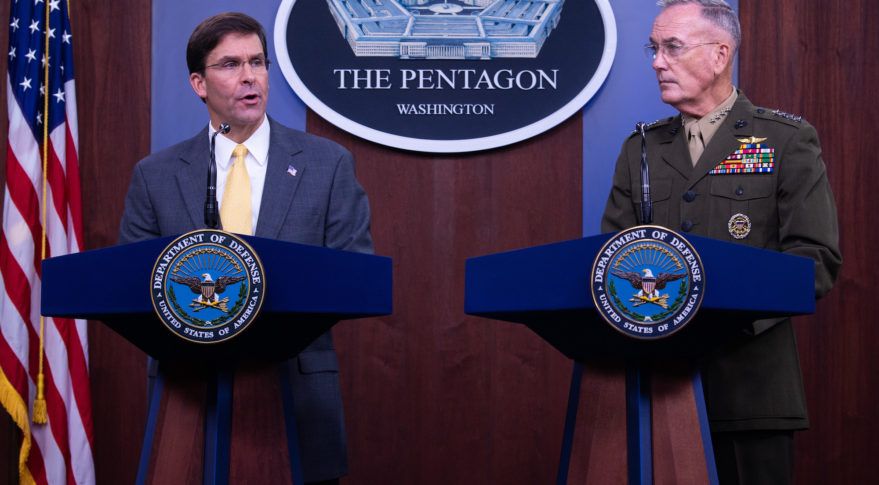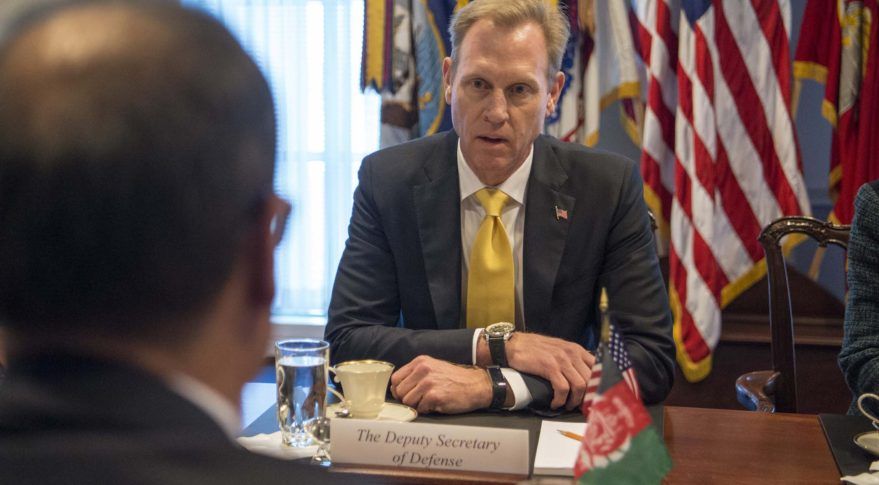What Happens to Space Force After Trump?
Article by Samantha Masunaga December 15, 2020 (latimes.com)
• Chief of Space Operations Gen. John W. “Jay” Raymond says “proliferating technology” and “competitive interests” have changed space from a benign environment to “one in which we anticipate all aspects of human endeavor — including warfare.” The goals of Space Force include developing new capabilities, increasing cooperation and enabling a “lean and agile service.” Whether Space Force can achieve that mission is an open question. While Trump champions the initiative, he has done little to ensure it has the funding, staffing and authority to succeed. When he exits the White House next month, the Space Force’s trajectory remains unclear.
• Created last year as the first new armed service since 1947, Space Force has gained control of some space operations, but many others are still spread throughout the nation’s other military branches. Space Force is still technically part of the Air Force, just as the Marine Corps is part of the Navy. The Air Force’s Space Command is responsible for supporting and maintaining satellites for GPS, missile warning and nuclear command and control, as well as paying United Launch Alliance and SpaceX to launch national security satellites. “The whole point of this was to consolidate,” said Todd Harrison, senior fellow at the Center for Strategic and International Studies think tank. The US Army, US Navy, and especially the US Air Force all conduct space operations.
• Consolidating these disparate programs into the Space Force has been slow. Cape Canaveral Air Force Station and Patrick Air Force Base in Florida will change their names and become the first two Space Force installations. Eventually, all Air Force space missions are supposed to follow suit. But there has been no progress on integrating the Army‘s or Navy’s space missions.
• The Pentagon Space Force budget is lean. With about 2,100 personnel as of November 1st, Space Force commanded a budget of $40 million in 2020. Meanwhile, the Air Force has more than 325,000 active duty personnel and a budget of $168 billion for 2020. ($14B of that was designated to the Space Force.) The Space Force will probably always be the smallest military service, Harrison said. “Space is more dictated by capabilities than mass,” he said. Space Force “shouldn’t try to organize itself in the way of these much larger services because that’s not what it is. That’s not what it’s going to grow into.” For fiscal year 2021, the Space Force is requesting a budget transfer from the Air Force of $15.3 billion. Over time, as space programs from other services start consolidating into the Space Force, their budgets should follow.
• But David Deptula, a retired Air Force lieutenant general and dean of the Mitchell Institute for Aerospace Studies think tank, says that Space Force’s 2020 resources aren’t enough to carry out its mission of organizing, training and equipping forces to deter or defeat threats in space. US intelligence officials have warned that China and Russia have discussed developing new electronic warfare capabilities, which could have implications for U.S. military satellite communications or GPS satellite interference. “The nation is facing some very significant threats in the space realm,” says Deptula.
• “Space Force really needed to be stood up to remain competitive with the very real threats coming from our nearest adversaries,” said James Marceau, managing director of aerospace and defense at consulting firm Alvarez & Marsal, who has also served as a senior advisor to the Pentagon on major strategies including the Space Force. “We can’t afford to neglect that domain.”
• As the strategic role of satellites came to the forefront in the early 1990s, congressional leaders and military officials, including former Defense Secretary Donald H. Rumsfeld, considered consolidating space operations. In 2016, Representatives Jim Cooper (D-Tenn.) and Mike Rogers (R-Ala.) began advocating for a “space corps.” But there wasn’t enough support in the U.S. Senate for the proposal. Then, in March 2018, Trump seized upon the idea and suggested creating a ‘Space Force’ in a speech to Marines at Air Station Miramar in San Diego. (Cooper would later say Trump “tried to hijack” the idea of the space corps.) Five month later, Vice President Mike Pence announced the creation of Space Force. It was included in the 2020 National Defense Authorization Act and signed into law in December 2019.
• At this point, it’s “highly unlikely” that the Biden administration would try to eliminate the Space Force, Harrison said. It would require a vote in the U.S. House of Representatives and the Senate, as well as the president’s signature, he said. “I have not heard anyone seriously contemplating the idea of disestablishing it,” Harrison said. “It hasn’t even gotten a chance to get started yet.”
• “You’ve already transferred thousands of individuals into the Space Force,” said Doug Loverro, former deputy assistant secretary of Defense for space policy. “Can you imagine pulling the rug out from under them?” General Raymond says that he met with the Biden transition team in early December, and the conversation “was good”. So it appears that Space Force will be sticking around.
 President Trump has a penchant for grandiose promises that go unfulfilled. So when he announced a
President Trump has a penchant for grandiose promises that go unfulfilled. So when he announced a

plan to establish a Space Force, there was some skepticism.
Then-Sen. Bill Nelson (D-Fla.), ranking member on a Senate committee that deals with aviation and space, disliked the idea of consolidating space programs from the other military branches, saying at the time there were “too many important missions at stake” to “rip the Air Force apart.”
The idea of the new service became fodder for late-night comedians and a Netflix sitcom.
The Space Force, however, was not merely a presidential musing. Created last year as the first new armed service since 1947, it was established with the mission of protecting U.S. interests in space from potential adversaries, be they rival nations or gobs of space junk.

Whether it can achieve that mission is an open question. Though Trump champions the initiative, he has done little to ensure it has the funding, staffing and authority to succeed. When he exits the White House next month, the Space Force’s trajectory remains unclear.

The Space Force has gained control of some space operations, but many others are still spread throughout the nation’s other military branches.
Within the Defense Department, the Air Force has the lion’s share of space programs and budget for space operations. It’s responsible for supporting and maintaining satellites for GPS, missile warning and nuclear command and control, as well as paying United Launch Alliance and SpaceX to launch national security satellites.
The Army and Navy also have their own space operations.
Consolidating these disparate programs into the Space Force has been slow. Some Air Force missions have transferred to Space Force control or are in the process of doing so — last week, Vice President Mike Pence announced that Cape Canaveral Air Force Station and Patrick Air Force Base in Florida would change their names and become the first two Space Force installations. Eventually, all Air Force space missions are supposed to follow suit. But there has been no progress on integrating the Army‘s or Navy’s space missions.

“The last thing you want … after all of this reorganization and creating a new military service is to continue to have the fragmentation of our space programs and space organizations across the military,” said Todd Harrison, senior fellow at the Center for Strategic and International Studies think tank. “The whole point of this was to consolidate.”

Compared with the budgets and personnel of the other branches of the U.S. military, the Space Force is lean. And technically it’s part of the Air Force, just as the Marine Corps is part of the Navy.
Consisting of about 2,100 people as of Nov. 1, the Space Force commanded a budget of $40 million for its operations and maintenance in fiscal year 2020.
Meanwhile, the Air Force has more than 325,000 active duty personnel and a budget of $168 billion for fiscal 2020. (The Air Force designated almost $14 billion of that for space capabilities. These projects have since become part of the Space Force.)
The Space Force will probably always be the smallest military service, Harrison said.
“Space is more dictated by capabilities than mass,” he said. The Space Force “shouldn’t try to organize itself in the way of these much larger services because that’s not what it is. That’s not what it’s going to grow into.”

But the Space Force’s 2020 resources aren’t enough to carry out its mission of organizing, training and equipping forces to deter or defeat threats in space, said David Deptula, a retired Air Force lieutenant general and dean of the Mitchell Institute for Aerospace Studies think tank.
For fiscal year 2021, the Space Force is requesting a budget transfer from the Air Force of $15.3 billion. And over time, as space programs from other services start consolidating into the Space Force, their budgets should follow.
“The nation is facing some very significant threats in the space realm,” Deptula said. “Let’s make sure that service is set up for success.”
U.S. intelligence officials have warned that China and Russia have discussed developing new electronic warfare capabilities, which could have implications for U.S. military satellite communications or GPS satellite interference. In 2007, China tested an anti-satellite weapon and destroyed one of its own inactive weather satellites.
“Space Force really needed to be stood up to remain competitive with the very real threats coming from our nearest adversaries,” said James Marceau, managing director of aerospace and defense at consulting firm Alvarez & Marsal, who has also served as a senior advisor to the Pentagon on major strategies including the Space Force. “We can’t afford to neglect that domain.”
FAIR USE NOTICE: This page contains copyrighted material the use of which has not been specifically authorized by the copyright owner. ExoNews.org distributes this material for the purpose of news reporting, educational research, comment and criticism, constituting Fair Use under 17 U.S.C § 107. Please contact the Editor at ExoNews with any copyright issue.


 President Donald Trump says he’ll veto the 2021 National Defense Authorization Act (NDAA), the annual bill that sets the budget and policies for the U.S. military, if lawmakers don’t remove a bipartisan amendment to rename military bases named after Confederate leaders, according to an NBC News report.
President Donald Trump says he’ll veto the 2021 National Defense Authorization Act (NDAA), the annual bill that sets the budget and policies for the U.S. military, if lawmakers don’t remove a bipartisan amendment to rename military bases named after Confederate leaders, according to an NBC News report. raises and funding for new equipment, among other items. But it also includes language that could ultimately change what the American public knows about UFOs in a significant way. A Trump veto of the NDAA may stall the momentum of a movement that has rapidly captured mainstream attention over the last two years.
raises and funding for new equipment, among other items. But it also includes language that could ultimately change what the American public knows about UFOs in a significant way. A Trump veto of the NDAA may stall the momentum of a movement that has rapidly captured mainstream attention over the last two years.




 President Donald Trump officially launched the Space Force last month when he signed the National Defense Authorization Act into law. It will fall under the Department of the Air Force but is a distinct military service.
President Donald Trump officially launched the Space Force last month when he signed the National Defense Authorization Act into law. It will fall under the Department of the Air Force but is a distinct military service.


